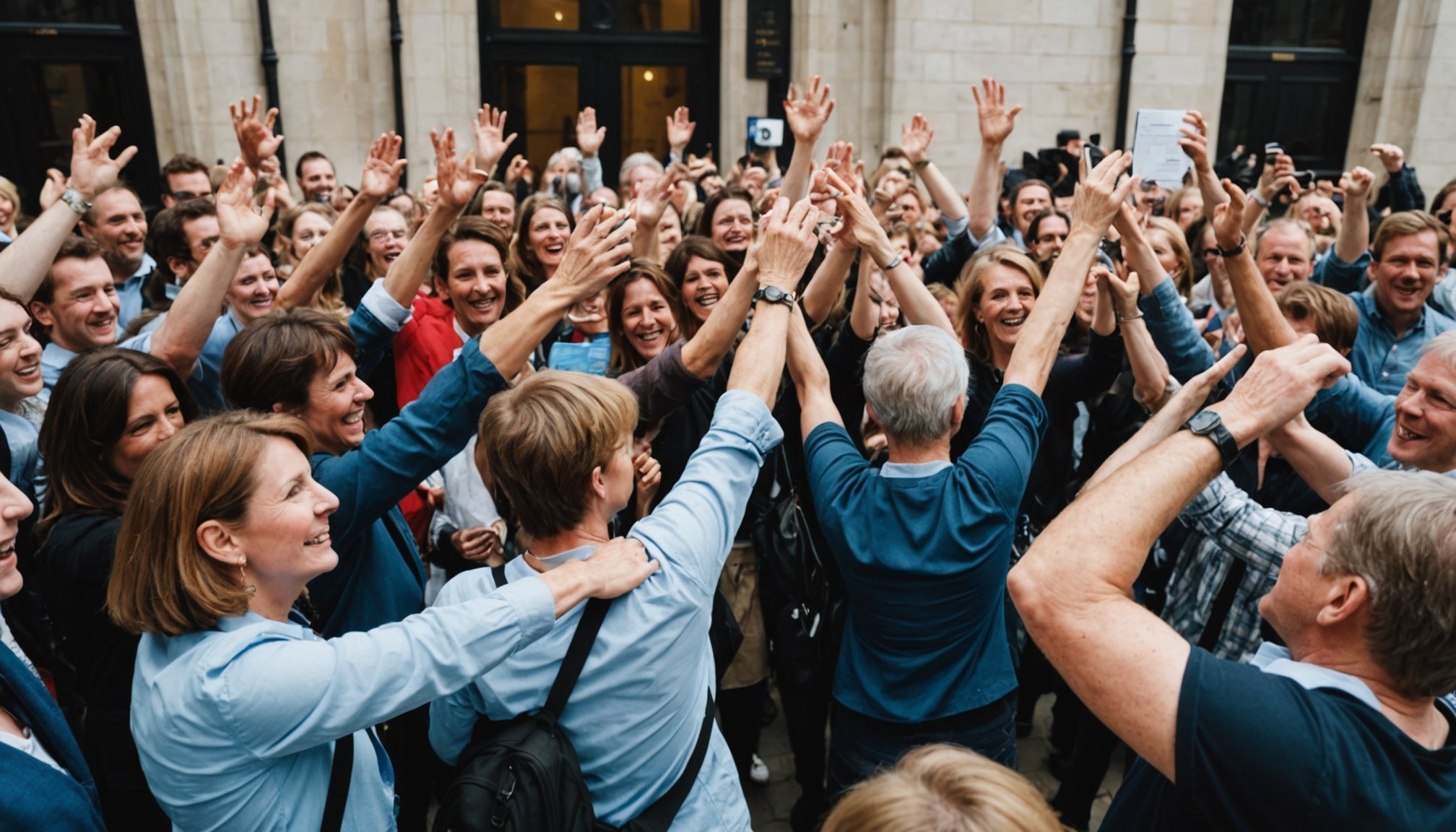Unleashing Potential: Innovative Crowdsourcing Strategies for UK Non-Profits to Elevate Community Fundraising Success
In the ever-evolving landscape of non-profit fundraising, UK charities are increasingly turning to innovative crowdsourcing strategies to amplify their community impact. This article delves into the world of crowdsourcing, exploring how non-profits can leverage new technologies, social media, and community engagement to achieve unprecedented fundraising success.
The Power of Crowdsourcing in Fundraising
Crowdsourcing, the practice of obtaining information, services, or funding by soliciting contributions from a large group of people, has revolutionized the way non-profits approach fundraising. This method is particularly effective in the UK, where a strong sense of community and social responsibility prevails.
Also to see : Transforming Property Showings: The Impact of Augmented Reality on Virtual Tours for UK Real Estate Professionals
Why Crowdsourcing Works
- Broad Reach: Crowdsourcing allows non-profits to reach a vast audience beyond traditional donor bases. Platforms like GoFundMe, Kickstarter, and JustGiving have made it easier for charities to share their stories and goals with a national and even global audience.
- Community Engagement: By involving the community directly in the fundraising process, non-profits can foster deeper donor relationships and a sense of ownership among supporters.
- Real-Time Feedback: Crowdsourcing platforms provide real-time updates and feedback, enabling non-profits to adjust their strategies based on immediate responses from the public.
Leveraging Social Media for Crowdsourcing
Social media has become an indispensable tool for non-profits looking to maximize their crowdsourcing efforts. Here’s how UK charities can harness the power of social media:
Building a Strong Online Presence
- Choose the Right Platforms: Focus on platforms where your target audience is most active. For example, Instagram and TikTok are ideal for visual storytelling, while Twitter and Facebook can be used for real-time updates and engagement.
- High-Resolution Content: Use high-quality images and videos to tell compelling stories. Visual content can significantly improve engagement and sharing rates.
- Engage with Followers: Respond to comments, messages, and mentions promptly. This helps build a loyal community that is more likely to support your fundraising campaigns.
Case Study: The Ice Bucket Challenge
The Ice Bucket Challenge, which went viral in 2014, is a prime example of how social media can drive crowdsourcing success. The challenge, which raised awareness and funds for ALS research, involved participants dumping ice water over their heads and nominating others to do the same. This campaign raised millions of dollars globally and demonstrated the potential of social media in mobilizing public support.
Topic to read : Unlocking Seamless Virtual and Hybrid Experiences: Key Strategies for UK Event Planners
Data Analysis and Machine Learning in Crowdsourcing
The use of data analysis and machine learning can significantly enhance the effectiveness of crowdsourcing campaigns.
Understanding Donor Behavior
- Data Collection: Utilize data from past campaigns to understand donor behavior, preferences, and giving patterns.
- Segmentation: Segment your donor base to tailor your appeals and communications, increasing the likelihood of successful fundraising.
- Predictive Analytics: Use machine learning algorithms to predict donor responses and optimize your fundraising strategies accordingly.
Example: The British Red Cross
The British Red Cross has been at the forefront of using data analysis to improve their fundraising efforts. By analyzing donor data, they have been able to identify high-value donors and tailor their appeals to maximize donations.
Collaborating with Local Authorities and Businesses
Collaboration with local authorities and businesses can provide non-profits with additional resources and support.
Local Authorities
- Government Grants: Many local authorities offer grants and funding opportunities for non-profits. Research these opportunities and apply for grants that align with your mission.
- Community Events: Partner with local authorities to organize community events that can help raise funds and awareness.
Business Partnerships
- Corporate Social Responsibility: Many businesses have corporate social responsibility programs that include philanthropic initiatives. Seek out partnerships that can provide financial support, resources, or volunteer time.
- Matching Gifts: Some businesses offer matching gift programs where they match donations made by their employees. This can significantly boost your fundraising totals.
Ensuring Privacy and Transparency
As non-profits collect and use donor data, it is crucial to ensure privacy and transparency.
Privacy Policy
- Clear Communication: Have a clear and accessible privacy policy that explains how donor data is collected, used, and protected.
- Compliance: Ensure compliance with data protection laws such as the GDPR to maintain trust with your donors.
Transparency in Fundraising
- Open Reporting: Provide regular updates on how funds are being used. Transparency builds trust and encourages continued support.
- Services and Impact: Clearly communicate the services and impact of your non-profit to donors, highlighting the real-world difference their contributions make.
Innovative Fundraising Strategies
Here are some innovative fundraising strategies that UK non-profits can adopt:
Crowdfunding Campaigns
- Platform Selection: Choose the right crowdfunding platform based on your goals and target audience. For example, Kickstarter is ideal for project-based funding, while GoFundMe is better suited for personal or community-based campaigns.
- Storytelling: Use compelling stories and high-quality content to engage potential donors.
Peer-to-Peer Fundraising
- Empower Volunteers: Empower your volunteers and supporters to become fundraisers themselves. Provide them with the tools and resources they need to set up their own fundraising pages.
- Social Media Integration: Integrate peer-to-peer fundraising with social media to amplify reach and engagement.
Gamification and Challenges
- Engaging Activities: Create engaging activities or challenges that encourage participation and donations. For example, charity runs, cycling events, or bake sales can be highly effective.
- Real-Time Updates: Use social media to provide real-time updates and leaderboards to keep participants and donors engaged.
Practical Insights and Actionable Advice
Here are some practical insights and actionable advice for UK non-profits looking to enhance their crowdsourcing efforts:
Building Donor Relationships
- Personalized Communication: Use data analysis to personalize your communications with donors, addressing them by name and acknowledging their past contributions.
- Regular Updates: Keep donors informed about the impact of their donations through regular updates and newsletters.
Improving Access to Services
- Infrastructure Development: Invest in developing a robust infrastructure that includes a user-friendly website, efficient donation processing, and reliable customer support.
- Accessibility: Ensure that your fundraising platforms and communications are accessible to all, including those with disabilities.
Crowdsourcing is a powerful tool that UK non-profits can leverage to elevate their community fundraising success. By harnessing the power of social media, leveraging data analysis and machine learning, collaborating with local authorities and businesses, ensuring privacy and transparency, and adopting innovative fundraising strategies, non-profits can achieve remarkable results.
Key Takeaways
- Use Social Media Effectively: Build a strong online presence and engage with your followers to maximize your reach.
- Analyze Data: Use data analysis and machine learning to understand donor behavior and optimize your fundraising strategies.
- Collaborate: Partner with local authorities and businesses to access additional resources and support.
- Ensure Transparency: Maintain transparency in your fundraising efforts and protect donor data to build trust.
By embracing these strategies, UK non-profits can unlock new avenues for fundraising success, ultimately enhancing their ability to support and serve their communities.
Table: Comparative Analysis of Crowdfunding Platforms
| Platform | Ideal For | Fees | Key Features |
|---|---|---|---|
| GoFundMe | Personal/Community | 2.9% + 0.30 per transaction | Easy setup, social media integration, real-time updates |
| Kickstarter | Project-Based | 5% of total funds raised + payment processing fees | All-or-nothing funding model, project-based focus |
| JustGiving | Charitable Causes | 5% of total funds raised + payment processing fees | Integration with social media, charity-focused features |
| Crowdfunder | Business/Community | 4% of total funds raised + payment processing fees | Flexible funding models, business and community focus |
Quotes from Experts
- “Crowdsourcing has been a game-changer for our non-profit. It allows us to reach a wider audience and engage our community in a more meaningful way.” – Sarah Johnson, Director of Fundraising, UK Charity
- “Data analysis is crucial in understanding donor behavior and optimizing our fundraising strategies. It helps us make informed decisions and improve our overall fundraising success.” – Mark Davis, Data Analyst, British Red Cross
- “Transparency is key in building trust with our donors. We ensure that our donors know exactly how their contributions are being used and the impact they are making.” – Emily Wilson, Fundraising Manager, Local UK Non-Profit
By combining these insights with a deep understanding of the community and the use of innovative technologies, UK non-profits can unleash their full potential and achieve remarkable fundraising success.







